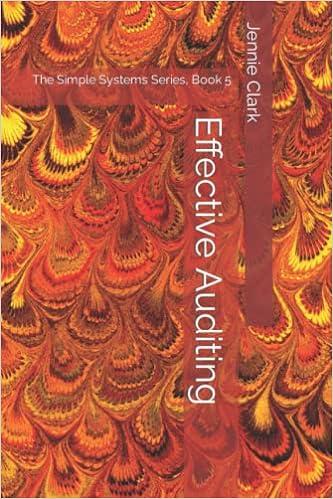Question
Case 1.9 Cleveland Custom Cabinets Cleveland Custom Cabinets is a specialty cabinet manufacturer for high-end homes in the Cleveland Heights and Shaker Heights areas. The
Case 1.9 Cleveland Custom Cabinets Cleveland Custom Cabinets is a specialty cabinet manufacturer for high-end homes in the Cleveland Heights and Shaker Heights areas. The company manufactures cabinets built to the specifications of homeowners and employs 125 custom cabinetmakers and installers. There are 30 administrative and sales staff members working for the company.
James Leroy owns Cleveland Custom Cabinets. His accounting manager is Marcus Sims, who reports to the director of finance. Sims manages 15 accountants. The staff is responsible for keeping track of manufacturing costs by job and preparing internal and external financial reports. The internal reports are used by management for decision making. The external reports are used to support bank loan applications.
The company applies overhead to jobs based on direct labor hours. For 2016, it estimated total overhead to be $4.8 million and 80,000 direct labor hours. The cost of direct materials used during the first quarter of the year is $600,000, and direct labor cost is $400,000 (based on 20,000 hours worked). The companys accounting system is old and does not provide actual overhead information until about four weeks after the close of a quarter. As a result, the applied overhead amount is used for quarterly reports.
On April 10, 2016, Leroy came into Simss office to pick up the quarterly report. He looked at it aghast. Leroy had planned to take the statements to the bank the next day and meet with the vice president to discuss a $1 million working capital loan. He knew the bank would be reluctant to grant the loan based on the income numbers in Exhibit 1. Without the money, Cleveland could have problems financing everyday operations.
Exhibit 1
Cleveland Custom Cabinets
Net Income for the Quarter Ended March 31, 2016
Sales $6,400,000
Cost of goods sold 4,800,000
Gross margin $1,600,000 S
elling and administrative expenses 1,510,000
Net income $ 90,000
Leroy asked Sims to explain how net income could have gone from 14.2 percent of sales for the year ended December 31, 2015, to 1.4 percent for March 31, 2016. Sims pointed out that the estimated overhead cost had doubled for 2016 compared to the actual cost for 2015. He explained to Leroy that rent had doubled and the cost of utilities skyrocketed. In addition, the custom-making machinery was wearing out more rapidly, so the companys repair and maintenance costs also doubled from 2015.
Leroy wouldnt accept Simss explanation. Instead, he told Sims that the quarterly income had to be at least the same percentage of sales as at December 31, 2015. Sims looked confused and reminded Leroy that the external auditors would wrap up their audit on April 30. Leroy told Sims not to worry about the auditors. He would take care of them. Furthermore, as the sole owner of the company, there is no reason not to 'tweak the numbers on a one-time basis. I own the board of directors, so no worries there. He went on to say, Do it this one time and I wont ask you to do it again. He then reminded Sims of his obligation to remain loyal to the company and its interests. Sims started to soften and asked Leroy just how he expected the tweaking to happen. Leroy flinched, held up his hands, and said, Ill leave the creative accounting to you.
Questions:
1.) Do you agree with Leroys statement that it doesnt matter what the numbers look like because he is the sole owner? Even if it is true that Sims owns the board of directors, what should be their role in this matter? What about the external auditors? Should Sims simply accept Leroys statement that he would handle them?
2.) (a) Assume that Sims is a CPA and holds the CMA. Put yourself in Simss position. What are your ethical considerations in deciding whether to tweak the numbers? (b) Assume you do a utilitarian analysis to help decide what to do. Evaluate the harms and benefits of alternative courses of action. What would you do? Would your analysis change if you use a rights theory approach?
3.) Think about how you would actually implement your chosen action. What barriers could you face? How would you overcome them? Is it worth jeopardizing your job in this case? Why or why not?
Grading:
Responses will be graded based on their ability to fully answer the questions (10 points), the strength of ties to chapter topics (6 points), and proper use of spelling and grammar (4 points).
Step by Step Solution
There are 3 Steps involved in it
Step: 1

Get Instant Access to Expert-Tailored Solutions
See step-by-step solutions with expert insights and AI powered tools for academic success
Step: 2

Step: 3

Ace Your Homework with AI
Get the answers you need in no time with our AI-driven, step-by-step assistance
Get Started


